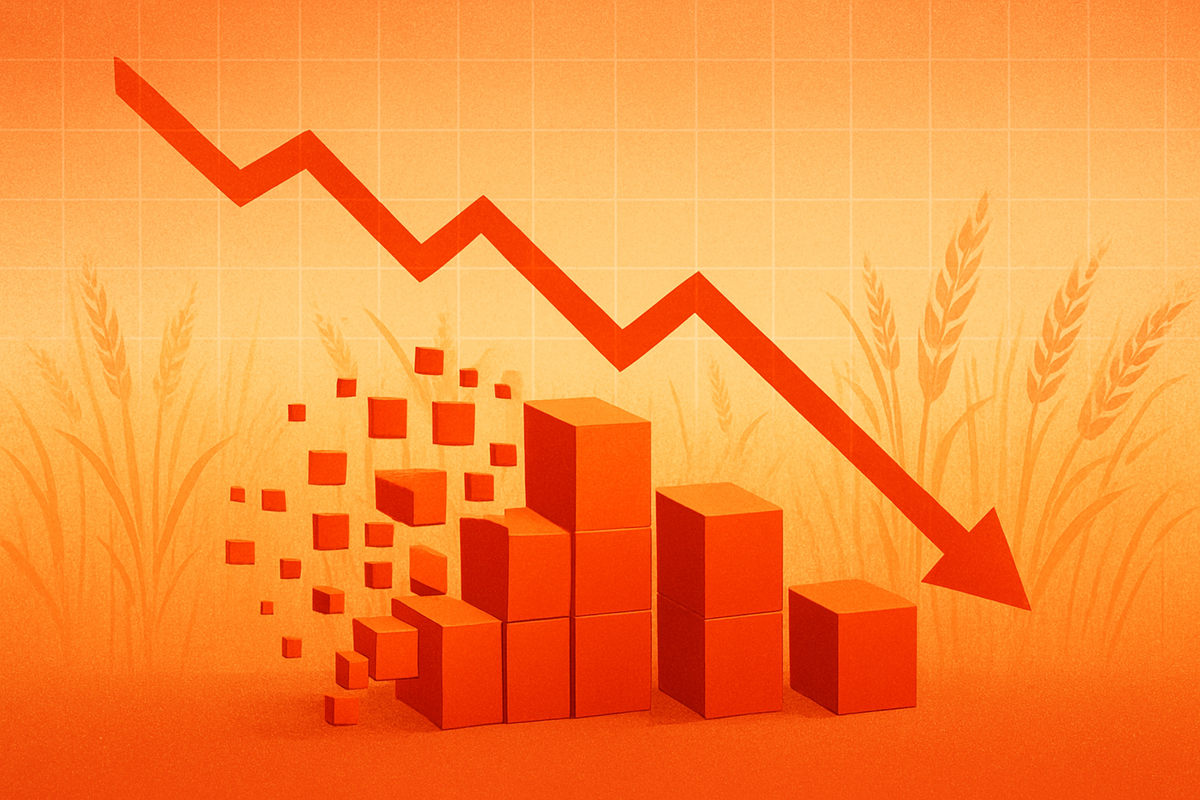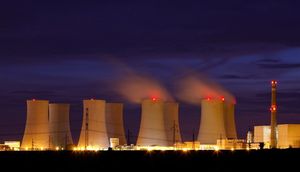
The Teucrium Commodity Trust (NYSEARCA: TAGS), a prominent issuer of commodity-focused exchange-traded funds, has reported significant financial losses for the third quarter of 2025, according to its SEC 10-Q filing on November 10, 2025. This challenging performance, primarily driven by unfavorable trading activities in commodity futures contracts, casts a spotlight on the volatile nature of the agricultural markets and the strategies employed by such investment vehicles. Concurrently, Teucrium Trading LLC, the sponsor of the Trust, announced a one-for-five reverse share split for its Teucrium Wheat Fund (NYSEARCA: WEAT), a move often indicative of sustained underperformance and an effort to manage share price levels.
The Q3 2025 report, covering the period ending September 30, 2025, reveals a total income loss of $(9,162,349) and a net income loss of $(10,850,151) for the three months. These figures underscore a difficult quarter for the Trust, which manages various funds including the Teucrium Corn Fund (NYSEARCA: CORN), Teucrium Sugar Fund (NYSEARCA: CANE), Teucrium Soybean Fund (NYSEARCA: SOYB), and Teucrium Wheat Fund (NYSEARCA: WEAT). The realized losses on futures contracts were the primary culprit, suggesting that the underlying commodity markets tracked by these funds experienced significant depreciation or adverse market conditions during the quarter. Adding to the financial pressures, the Trust also noted a decrease in interest income compared to the previous year, further impacting its overall profitability.
Unpacking the Quarter's Challenges: Losses and a Strategic Split
The core of Teucrium Commodity Trust's (NYSEARCA: TAGS) Q3 2025 woes stems from its trading activities in commodity futures. The substantial net losses reported for the quarter ending September 30, 2025, reflect a period where the Trust's long positions in various agricultural commodity futures likely faced downward price pressure. This could be due to a combination of factors, including robust global harvests leading to oversupply, decreased demand, or the inherent challenges of managing futures contracts in a "contango" market, where later-dated contracts are more expensive than nearer ones, leading to negative roll yield losses upon contract expiration.
Adding to the narrative, on November 4, 2025, Teucrium Trading LLC announced a one-for-five reverse share split for the Teucrium Wheat Fund (NYSEARCA: WEAT). This corporate action, scheduled to become effective on November 25, 2025, will consolidate every five pre-split shares into one post-split share, proportionately increasing the net asset value (NAV) per share by five times. While this move does not alter the total value of an investor's holding, it typically aims to boost a fund's per-share price, often to meet exchange listing requirements or improve market perception after a period of sustained price decline. The Teucrium Wheat Fund (NYSEARCA: WEAT) has indeed seen its value decline by 15.43% over the past year and 10.17% year-to-date as of early November 2025, trading within a 52-week range of $3.99-$5.35. The new CUSIP number for WEAT will be 88166A870.
The timeline of events highlights the immediate response to challenging market conditions. The losses accumulated during the quarter ending September 30, 2025, and the subsequent announcement of the reverse split in early November, underscore the dynamic and often reactive nature of commodity fund management. Key players involved are primarily Teucrium Trading LLC, as the sponsor, and the investors in the various Teucrium funds. Initial market reactions to such news often involve heightened scrutiny from investors and analysts, with some potentially re-evaluating their positions in commodity-linked investment vehicles. While specific market reactions to this particular report are still unfolding as of its filing date, similar events have historically led to increased caution in the broader commodity ETF space.
Shifting Fortunes: Potential Winners and Losers in the Commodity Futures Arena
The challenging performance of the Teucrium Commodity Trust (NYSEARCA: TAGS) and the reverse split of its Teucrium Wheat Fund (NYSEARCA: WEAT) signal potential shifts in fortunes across the commodity futures landscape. Companies and investors deeply entrenched in agricultural commodities, particularly wheat, could face headwinds, while others with diversified strategies or specialized hedging solutions might find opportunities.
Potential Losers:
- Specialized Agricultural Commodity Fund Issuers: Other public companies that issue similar single-commodity or narrowly focused agricultural ETFs could experience similar pressures, including investor outflows and reputational damage, if the broader agricultural market trends remain unfavorable.
- Agricultural Trading Firms and Merchants: Companies like Archer-Daniels-Midland Company (NYSE: ADM) or Bunge Global SA (NYSE: BG), heavily involved in the physical trading and processing of agricultural commodities, might face reduced demand, increased volatility, and tighter margins if the underlying market conditions reflected in Teucrium's losses persist. Their hedging strategies would be crucial in mitigating these impacts.
- Brokerage Firms with High Exposure to Agricultural ETFs: Brokerage houses whose revenue streams are significantly reliant on commissions from trading underperforming agricultural commodity ETFs or managing assets in such funds could see a decline in business.
Potential Winners:
- Diversified Financial Institutions: Large, diversified banks and financial services firms, such as JPMorgan Chase & Co. (NYSE: JPM) or Goldman Sachs Group Inc. (NYSE: GS), with broad offerings across multiple asset classes and sophisticated risk management capabilities, are better positioned to absorb losses in one specific area. They might even benefit from increased market volatility as clients seek more complex hedging solutions or alternative investment strategies.
- Risk Management and Advisory Firms: Companies specializing in commodity risk management, hedging strategies, and market analysis could see increased demand from institutional clients and corporations looking to navigate volatile commodity markets.
- Technology Providers for Futures Markets: Firms offering advanced trading platforms, data analytics, and risk management software for commodity futures could see continued demand as market participants seek better tools to manage uncertainty and optimize trading strategies.
- Alternative Investment Managers (Macro Hedge Funds): Funds that employ macro strategies and can take both long and short positions across various asset classes, including commodities, might profit from market dislocations and volatility, potentially attracting capital from investors seeking uncorrelated returns.
- Companies with Robust Hedging Programs: Industrial companies (e.g., food processors like Tyson Foods, Inc. (NYSE: TSN) or Conagra Brands, Inc. (NYSE: CAG)) that effectively use commodity futures to hedge their input costs might see their profitability improve relative to competitors who failed to hedge or hedged poorly during a period of market turmoil.
Wider Significance: Echoes in the Broader Commodity Landscape
The Teucrium Commodity Trust's (NYSEARCA: TAGS) Q3 2025 report, detailing significant losses and the subsequent reverse split of the Teucrium Wheat Fund (NYSEARCA: WEAT), resonates beyond the immediate performance of these specific funds, offering insights into broader industry trends and potential ripple effects across the commodity futures market.
This event underscores the inherent volatility and structural challenges faced by long-only commodity ETFs, particularly in agricultural markets. Persistent periods of "contango," where futures prices for distant delivery are higher than near-term prices, can lead to negative roll yield, eroding returns even if spot prices remain stable. The reported losses suggest that Teucrium's funds were caught in such an environment or experienced outright price declines in the underlying commodities. This fits into a broader trend of increased scrutiny from investors regarding the mechanics and costs associated with maintaining exposure to commodity futures through passively managed funds.
The reverse split of the Teucrium Wheat Fund (NYSEARCA: WEAT) is a clear indicator of sustained underperformance in wheat futures. While a corporate action designed to manage share price and maintain exchange listing, it serves as a lagging signal of fundamental challenges in the underlying asset. This could have ripple effects on investor confidence in other single-commodity agricultural ETFs, potentially leading to capital reallocation towards broader commodity indices, diversified multi-commodity funds, or entirely different asset classes perceived as more stable. The perception of wheat as a struggling asset could also influence futures trading behavior, potentially contributing to a bearish sentiment in the short term.
From a regulatory perspective, the SEC 10-Q filing ensures transparency. However, a pattern of significant losses or repeated reverse splits across the industry could prompt regulators to enhance disclosure requirements or issue further guidance on investor protection for commodity-linked products, particularly concerning risk disclosure and suitability. Historical precedents abound in the commodity futures market. The unprecedented collapse of crude oil prices in April 2020 saw several oil-linked ETFs, such as the United States Oil Fund (NYSEARCA: USO), undertake multiple reverse splits to manage extreme contango and maintain operational viability. Similarly, natural gas ETFs have a history of high volatility and contango-induced losses, leading to share adjustments over time. These examples serve as stark reminders of the inherent risks and complexities involved in investing in commodity futures through passively managed funds, highlighting that Teucrium's current situation, while challenging, is not without historical parallels.
What Comes Next: Navigating the Commodity Futures Landscape
The Teucrium Commodity Trust's (NYSEARCA: TAGS) Q3 2025 report and the Teucrium Wheat Fund's (NYSEARCA: WEAT) reverse split set the stage for an evolving landscape in commodity futures. Both short-term adjustments and long-term strategic pivots will be crucial for fund managers and investors alike.
In the short term, increased volatility in WEAT shares is expected as the reverse split takes effect on November 25, 2025. This, coupled with the reported Q3 losses, is likely to foster investor caution across Teucrium's agricultural funds. The persistence of contango in wheat and other agricultural commodity markets will continue to pose a significant challenge, potentially eroding returns as funds roll over futures contracts. Furthermore, the USDA's outlook for 2026 suggests full bins and soft prices for corn, soybeans, and wheat, implying continued pressure on agricultural commodity prices due to oversupply and strong global competition from producers like Russia, Canada, and Argentina. Geopolitical and trade tensions will also remain influential, with potential disruptions to agricultural trade flows, particularly impacting U.S. agricultural exports.
Long-term possibilities suggest a more nuanced picture. While aggregate commodity prices are generally forecast to decline slightly in 2025 and 2026, a stabilization by mid-2026 and a recovery into 2027 are anticipated as global economic activity improves. This could offer a potential rebound for commodity funds that can effectively navigate the current downturn. However, a key trend is the divergence in commodity performance. While agricultural commodities and base metals may face pressure, natural gas and precious metals like gold are expected to outperform due to strong export flows, safe-haven demand, and strategic diversification by central banks and institutional investors. This divergence might prompt Teucrium to consider broadening its commodity exposure beyond its current agriculture-heavy focus to capture diverse market opportunities.
Strategic pivots for Teucrium and similar fund managers could involve enhanced risk management strategies to mitigate the impact of contango, such as more sophisticated futures rolling techniques. Diversification of fund offerings, potentially through new funds with exposure to outperforming sectors like precious metals or natural gas, could also be explored. The adoption of active management strategies, moving beyond passive indexing, could add value by exploiting market inefficiencies. Lastly, a strong emphasis on investor education and transparency, especially regarding corporate actions like reverse splits, will be vital to maintain investor confidence.
Market opportunities may emerge in precious metals, with gold seeing increased institutional and retail investment as a safe-haven asset. The broader energy transition could also create opportunities in specific commodities related to renewable energy infrastructure. Conversely, challenges include persistent macroeconomic headwinds, continued oversupply in key agricultural commodities, ongoing geopolitical instability, and regulatory scrutiny. The structural issue of contango remains a consistent hurdle for passively managed commodity funds.
Potential scenarios range from a challenging recovery for Teucrium's agricultural funds if market conditions remain soft, to a strategic pivot and diversification that leads to a more resilient portfolio. A less likely but possible scenario involves an agricultural rebound due to unforeseen supply shocks. The ability of Teucrium and other funds to adapt to these challenges and capitalize on emerging opportunities will dictate their future success in the dynamic commodity futures market.
Comprehensive Wrap-up: Navigating Volatility in Commodity Futures
The Teucrium Commodity Trust's (NYSEARCA: TAGS) Q3 2025 SEC 10-Q report serves as a stark reminder of the inherent volatility and complex dynamics within the commodity futures market. The reported significant financial losses, coupled with the strategic one-for-five reverse share split of the Teucrium Wheat Fund (NYSEARCA: WEAT), highlight a challenging period for agricultural commodities and the investment vehicles that track them.
Key takeaways from the event include the substantial financial underperformance of the Trust during Q3 2025, primarily due to realized losses on futures contracts. This indicates that market conditions for the underlying agricultural commodities (corn, sugar, soybean, wheat) were unfavorable, potentially exacerbated by factors like contango and oversupply. The reverse split for WEAT, effective November 25, 2025, while a technical adjustment to manage share price, signals sustained weakness in wheat futures.
Looking forward, the assessment of the market suggests continued headwinds for agricultural commodities in the short term, driven by potential oversupply and geopolitical uncertainties. However, the broader commodity market may see a stabilization and gradual recovery into 2027, with certain sectors like precious metals and natural gas potentially outperforming. This divergence in performance underscores the importance of diversified strategies.
Final thoughts on significance and lasting impact point to the ongoing need for investors to understand the unique risks associated with commodity-linked ETFs, particularly those with long-only strategies susceptible to negative roll yield. This event may encourage greater scrutiny of fund structures, expense ratios, and risk management practices across the industry.
What investors should watch for in the coming months includes the performance of individual Teucrium commodity funds for signs of recovery or continued struggles, particularly the post-split behavior of WEAT. Close attention should be paid to broader agricultural commodity market trends, global supply and demand dynamics, and the macroeconomic environment, including interest rate policies and trade relations. Future SEC filings and management commentary from Teucrium (Teucrium Trading LLC) will also provide crucial insights into their strategies for navigating current market conditions. Ultimately, the event reinforces the critical importance of a diversified portfolio and robust risk management for anyone investing in the dynamic and often unpredictable world of commodity futures.
This content is intended for informational purposes only and is not financial advice


















